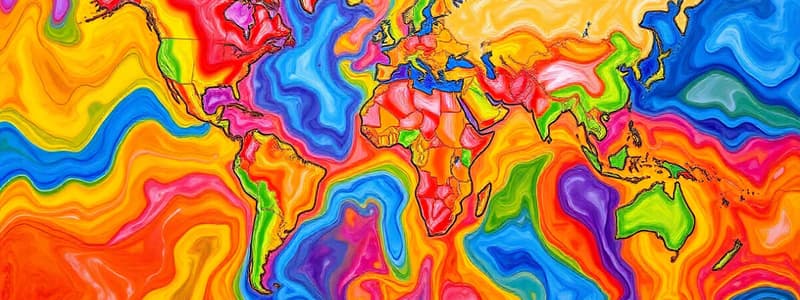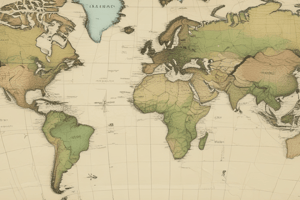Podcast
Questions and Answers
What is a characteristic of Cartesian coordinates?
What is a characteristic of Cartesian coordinates?
- They represent geographical coordinates.
- They vary depending on the location on Earth.
- They are known as projected coordinates. (correct)
- They can only be used in large-scale maps.
The length of one degree remains constant regardless of location on Earth.
The length of one degree remains constant regardless of location on Earth.
False (B)
What does UTM stand for?
What does UTM stand for?
Universal Transverse Mercator
How many times larger is Africa compared to Greenland?
How many times larger is Africa compared to Greenland?
Conical projections are useful for representing high-latitude regions.
Conical projections are useful for representing high-latitude regions.
The UTM grid references divide the world into ____ degree longitudinal zones.
The UTM grid references divide the world into ____ degree longitudinal zones.
What is the basic pattern of conic projections?
What is the basic pattern of conic projections?
Match the following UTM grid zone designations with their hemispheres:
Match the following UTM grid zone designations with their hemispheres:
The distortion in conical projections increases with distance from the __________.
The distortion in conical projections increases with distance from the __________.
Match the following aspects of conical projections with their characteristics:
Match the following aspects of conical projections with their characteristics:
Which projection is known for preserving area but has issues with shape?
Which projection is known for preserving area but has issues with shape?
The Mercator projection is an equal area projection.
The Mercator projection is an equal area projection.
What type of projection is also referred to as 'plate carre'?
What type of projection is also referred to as 'plate carre'?
The ________________ projection minimizes distortion and is also known as the interrupted projection.
The ________________ projection minimizes distortion and is also known as the interrupted projection.
Match the following projections with their main characteristics:
Match the following projections with their main characteristics:
Which projection is characterized by loxodromes appearing as straight lines?
Which projection is characterized by loxodromes appearing as straight lines?
The sinusoidal projection is not considered an equal area projection.
The sinusoidal projection is not considered an equal area projection.
What is the main purpose of the Gall-Peters projection?
What is the main purpose of the Gall-Peters projection?
What is true north?
What is true north?
Grid north is the same as true north no matter the location on Earth.
Grid north is the same as true north no matter the location on Earth.
What is the primary difference between magnetic north and true north?
What is the primary difference between magnetic north and true north?
The magnetic north is influenced by the Earth’s __________ at the observer's position.
The magnetic north is influenced by the Earth’s __________ at the observer's position.
Match the following types of north with their descriptions:
Match the following types of north with their descriptions:
What has been observed about the speed of the magnetic pole since the turn of the century?
What has been observed about the speed of the magnetic pole since the turn of the century?
The convergence angle is related to the difference between grid north and true north.
The convergence angle is related to the difference between grid north and true north.
Datums provide a frame of reference for measuring location on the surface of the __________.
Datums provide a frame of reference for measuring location on the surface of the __________.
What is the primary purpose of a datum in surveying?
What is the primary purpose of a datum in surveying?
The original North American Datum, NAD27, was based on the Clarke 1866 spheroid.
The original North American Datum, NAD27, was based on the Clarke 1866 spheroid.
What type of measurements did the NAVD29 datum provide a basis for?
What type of measurements did the NAVD29 datum provide a basis for?
NAD83 improved upon NAD27 by incorporating __________ data.
NAD83 improved upon NAD27 by incorporating __________ data.
Which spheroid model was used in the GRS80 ellipsoid that is functionally equivalent to WGS84?
Which spheroid model was used in the GRS80 ellipsoid that is functionally equivalent to WGS84?
The WGS84 and NAD83 datums are nearly identical in North America, with a difference of up to 50m.
The WGS84 and NAD83 datums are nearly identical in North America, with a difference of up to 50m.
Match the datum to its corresponding feature:
Match the datum to its corresponding feature:
What is the origin point for NAD27?
What is the origin point for NAD27?
Flashcards are hidden until you start studying
Study Notes
Cylindrical Projections
- Cylindrical projections distort areas and shapes.
- Minimal distortion occurs near the equator.
Equal Area Projection
- Orthographic projection is an equal area projection.
- Extreme distortion in polar regions.
- Not widely used because other equal area projections have less shape distortion.
- Example: Sinusoidal projections, Gall-Peters projection.
Equidistant Projection
- Also known as the Plate Carree projection.
- Distances along parallels are true to scale.
Sinusoidal Projection
- Starts with an equidistant projection and then scales all parallels to be true to scale.
- Equal area projection.
- Distortion increases as distance from the intersection of the equator and the central meridian increases.
Interrupted Projection
- Minimize distortion.
- Example: Goode Homolosine projection.
Mercator Projection
- Conformal projection.
- Adjusts spacing of parallels so that north-south distortion is equal to east-west distortion.
- Distortion is present at all points.
- Loxodromes appear as straight lines.
- Issue: Unequal areas, shapes appear stretched near the poles.
Gall-Peters Projection
- Equal area projection.
- Introduced in 1973 by Arno Peters.
- Introduced to challenge distortions caused by the Mercator projection.
- Issue: Shapes are distorted.
Mercator and Gall-Peters Projections Compared
- The Mercator Projection distorts areas.
- The Gall-Peters Projection distorts shapes.
Equal Earth Projection
- Extends the length of meridians.
- Parallels are straight.
- Preserves area.
- More appealing than the Gall Peters projection.
Africa on a World Map
- Africa is often depicted as being smaller than Greenland, however, Africa is 14 times larger.
Conical Projections
- One or two circles tangent to the globe.
- Meridians are radial straight lines.
- Parallels are concentric circular arcs.
- Distortion increases with distance from the standard line(s).
- Useful for projections of mid-latitude regions, like Canada and the United States.
Plane Coordinates
- Also known as projected coordinates.
- Use x and y Cartesian coordinates.
- Local coordinate system, often used for field survey work.
- Important for geographic information systems (GIS).
- Example: UTM (Universal Transverse Mercator) projection.
UTM Projection
- Normal cylindrical projection.
- Basis for Canadian topographic maps.
- Used in many other countries.
- Composite projection:
- The world is divided into 6 degree longitudinal zones.
- Each zone has a separate secant transverse Mercator projection centered on the central meridian of the zone.
- The UTM projection is used to minimize geometric distortion.
UTM Grid References
- Civilian System:
- Longitudinal zones are numbered 1 to 60, starting at 180 degrees west and moving east.
- Latitudinal zones are labeled C to X (omitting O and I), from south to north.
- Each zone is divided into the northern and southern hemispheres.
- Example: Kitchener-Waterloo in zone 17T.
Three Norths
- True North: The direction of the North Pole.
- Grid North: Based on rectangular UTM coordinates.
- Magnetic North: The direction sensed by a compass, influenced by Earth's magnetic field.
Magnetic Pole Movement
- The magnetic pole is speeding up, moving at a rate of 50 kilometers per year.
Declination Diagram
- Summarizes the relationships between the three norths.
- Magnetic Declination: The angle between true north and magnetic north.
- Convergence Angle: The angle between true north and grid north.
Datums
- Provide a frame of reference for measuring location on the surface of the Earth.
- Tie a spheroid (earth model) to the geoid and known locations on the Earth's surface.
- For Geodesists: Provide parameters for a coordinate system.
- For Local Surveyors: Provide a set of points with precise locations and reference elevations.
- All surveying is relative to a specific datum.
Original North American Datums
- 1900 US Standard Datum:
- First nationwide datum.
- Clark 1866 spheroid.
- NAD27:
- Based on the Clark 1866 spheroid.
- Origin at Meades Ranch, Kansas.
- Determined by visual triangulation.
- Used in the Oil and Gas Industry.
NAD83 and WGS84
- NAD83:
- Uses the GRS80 ellipsoid.
- Origin at the center of mass of the Earth.
- Based on satellite and laser data.
- Provides a more accurate representation of the Earth than earlier datums.
- WGS84:
- World Geodetic System.
- Entire Earth surveyed using satellites.
- Almost identical to NAD83 in North America.
- The system used for the globe and for GPS.
Studying That Suits You
Use AI to generate personalized quizzes and flashcards to suit your learning preferences.



